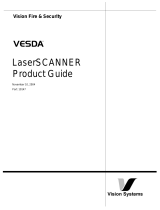Page is loading ...

AnaLASERTM
Air Sampling Detection
ENGINEER AND ARCHITECT SPECIFICATIONS
Introduction
The AnaLASERTM Control Card, Model ACC, is used in
AnaLASERTM control units and in conjunction with
AnaLASERTM air sampling detectors. The ACC displays
smoke intensity, measured by the detector, in an illumi-
nated bar graph display. One ACC is used for each
detector.
Smoke intensity, alarm conditions, and system troubles
can be communicated to fire alarm control panels via on
board dry contact relays. These same conditions are
stored in the ACC’s own history buffer. Finally, they can
also be output to a chart recorder or other recording
device.
Description/Operation
The ACC, housed in the control unit, is connected to the
AnaLASERTM detector via a six wire cable. Analog signals
for smoke and air flow are transmitted along this cable to
the ACC. Power to operate the detector and fan is also
carried on this cable.
The ACC provides all the visual and mechanical interaction
required to operate its respective detection zone. All
detection zone inputs, outputs and data ports are obtained
from plug in connectors located on the front of the card.
Each detection zone operates as a stand alone system.
The ACC is a microprocessor based device with several
programmable parameters. All programmable parameters
are factory set to default values. In most applications no
programming is required to make the system operational.
ACC AnaLASERTM Control Cards
lBargraph Display of Smoke Intensity
lMicroprocessor Controlled
lReal-time Monitoring via PC
lThree Field Programmable Alarm
Levels
lAlarm Verification at all Levels
lDetector Calibration Test
lDetector Isolate Switch
lAir Flow and Detector Status
Indicators
lOn-board History Storage
l Listed, FM Approved
1162
CATALOG NUMBER
firealarmresources.com

A history buffer stores information on past smoke levels
and events. The programmed information and history data
are stored in non-volatile memory. The system will retain
the configuration and history data following a CPU reset or
extended periods of power down conditions. Programming
and history data acquisition is done through a terminal or a
PC with terminal emulation software. By adding a modem,
offsite programming and real time monitoring can be
facilitated.
The ACC control functions are as follows:
Alarms
One fire alarm is selectable at any point along the bar
graph display. This alarm is generally intended to be
reported by the associated fire alarm system as a fire
alarm.
Two pre-alarms are selectable at any point along the bar
graph display. These are generally interpreted by fire alarm
systems to require investigation or to cause equipment
shutdown. A 0 to 60 second delay can be programmed for
each independent alarm level. This delay provides alarm
verification for that detector as required.
1. Bar Graph
The bar graph at the center of the control card displays the
detector’s continuous output of smoke level in 10%
increments of full scale. The absolute level of full scale is
dependent on the detector head sensitivity. Each bar
graph segment can be configured as a possible alarm
threshold.
2. Alarm Indicators
In normal operation (see “10, Isolate Switch”), the three
alarm LEDs located on the left side of the control card will
flash when their respective pre-set levels have been
reached and sustained for a period greater than their
respective alarm threshold timer delays. Their flashing also
indicates the operation of each alarm level’s output relay.
3. Normal Operation Indicator
When illuminated, indicates that all system functions are
operating and their are no active troubles.
4. Power Supply Trouble Indicator
When flashing, indicates that power has been transferred
to battery or that the power is outside the normal range.
5. Air Flow Trouble Indicator
When flashing, indicates loss of adequate flow through the
detector. Low flow level is programmable.
6. Detector Fail Indicator
When flashing, indicates that the detector needs servicing
or communication to the detector has been severed.
7. CPU Fail Indicator
When flashing, indicates the CPU is not running or is in the
reset mode.
8. Signal Offset Switch
When selected, will subtract ambient smoke levels up to
30% of the detector’s full scale obscuration. The modified
smoke reading is then used to control all output functions.
9. Signal Averaging Switch
When selected, the control card averages the smoke and
air flow signals over 2, 4 or 8 second intervals. The modi-
fied smoke reading is then used to control all output
functions.
10. Isolate Switch
When selected, disables all alarm outputs and indicators
regardless of smoke level. Used for system testing.
11. Alarm Levels Switch
When depressed, displays selected alarm levels on the bar
graph display.
12. Test Switch
When depressed, tests detector calibration. Bar graph will
read 80% of full scale when detector is properly calibrated.
13. Reset Switch
Resets all alarm and trouble conditions.
2/96
10M
CPY-IG
Printed in U.S.A.
February 1996
Supersedes sheet dated 4/95
Cerberus Pyrotronics
50 East Pearce Street
Richmond Hill, Ontario
L4B, 1B7 CN
Tel: (905) 764-8384
FAX: (905) 731-9182
Cerberus Pyrotronics
8 Ridgedale Avenue
Cedar Knolls, NJ 07927
Tel: (201) 267-1300
FAX: (201) 397-7008
firealarmresources.com
/







